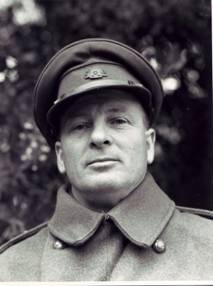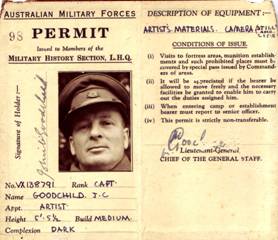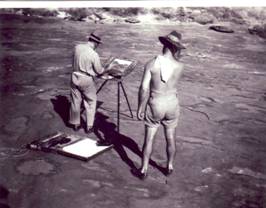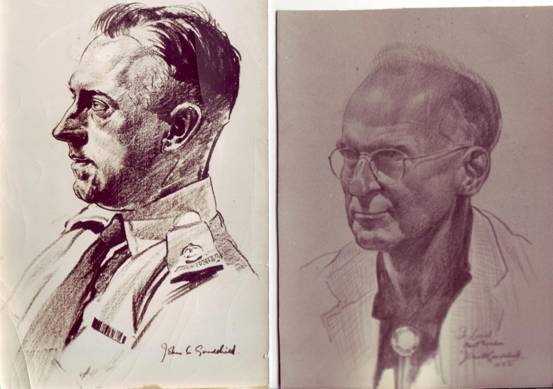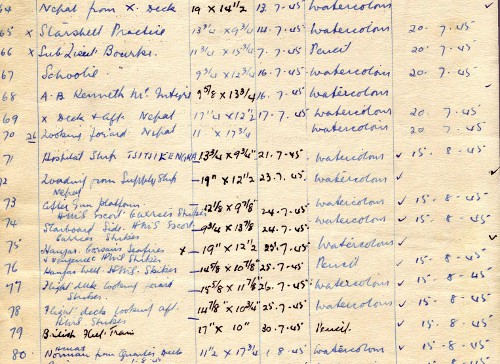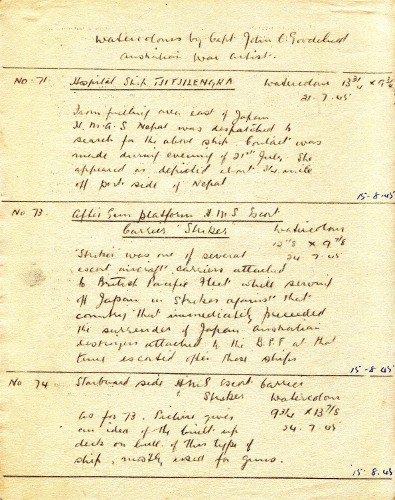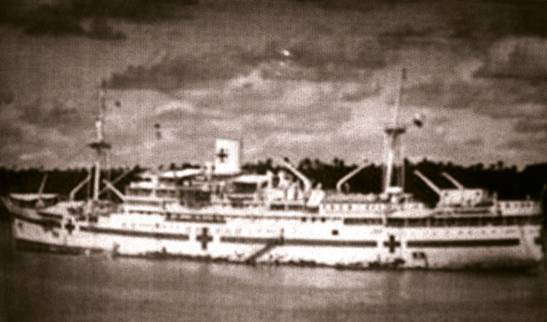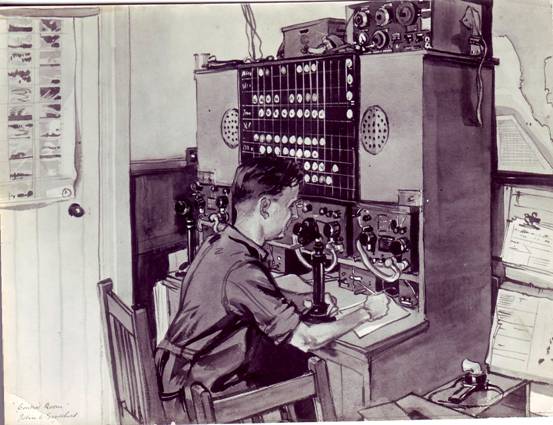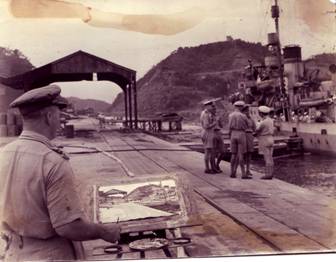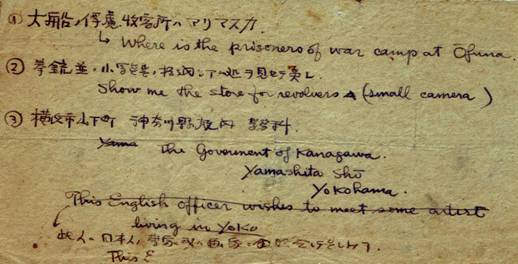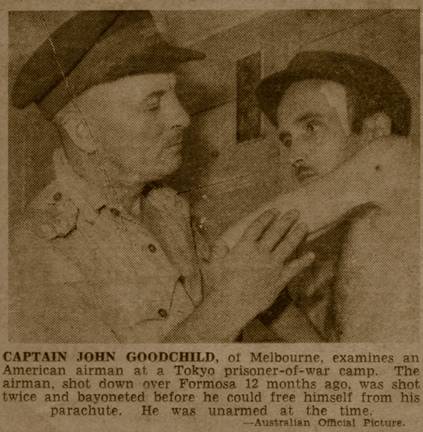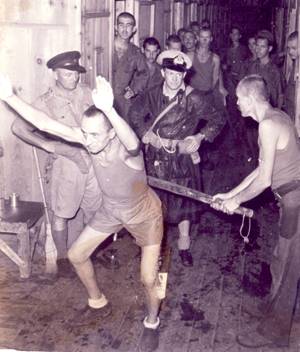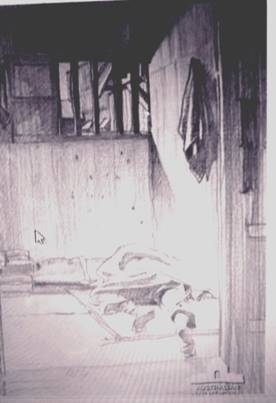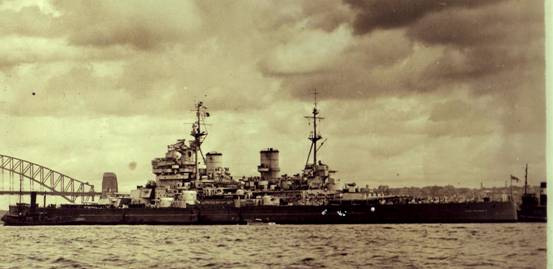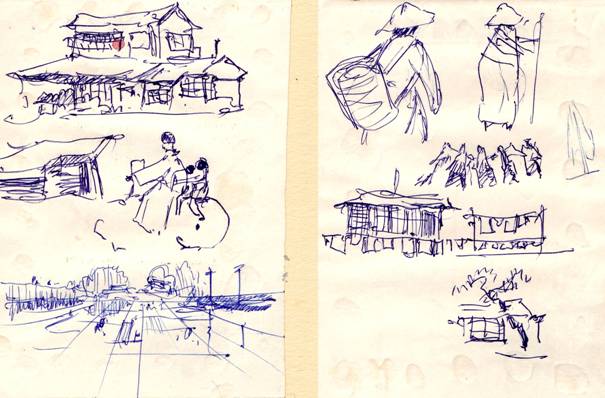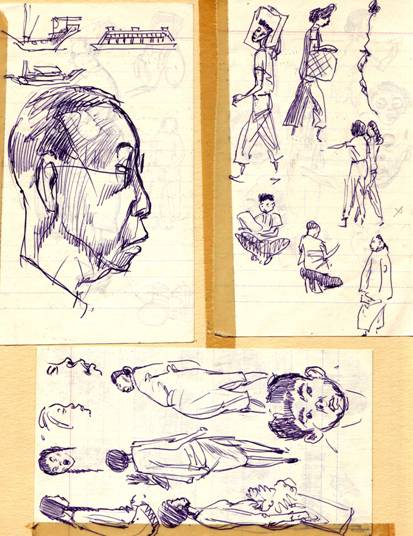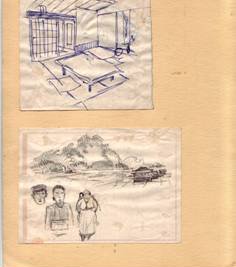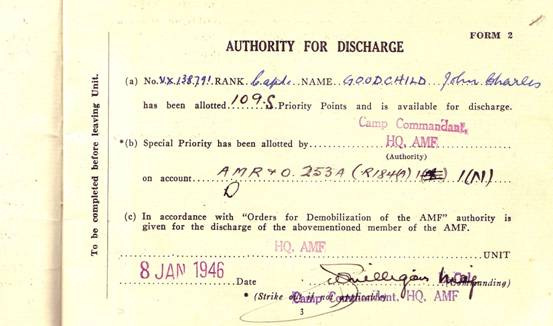
South Australian Medical Heritage Society Inc
Website for the Virtual Museum
Home
Coming meetings
Past meetings
About the Society
Main Galleries
Medicine
Surgery
Anaesthesia
X-rays
Hospitals,other organisations
Individuals of note
Small Galleries
Ethnic medicine
- Aboriginal
- Chinese
- Mediterran
Artist John C. Goodchild, World War 2
Acknowledgment: We are most grateful to Judith Brooks, who wrote about the activities of her father, Captain John Charles Goodchild, a war artist during the Second World War. She also provided us with many photographs and sketches. It provides an interesting sequel to his experiences as a stretcher bearer during WW1.
During the 1914-1918 war, John Goodchild served as a stretcher-bearer in northern France. After being hospitalised (and his drawing ability was subsequently noticed) he helped to illustrate "The Digger" magazine, and at the end of the war he was commissioned to draw Australian war graves in France for a publication titled "Where Australians Rest". It was given to all relatives of Australian soldiers who died in Europe and the Middle East. On his return to Australia, the Department of Repatriation paid for him to go to the South Australian School of Arts and Crafts.
By 1944 he was a successful artist exhibiting in Australia and overseas. In that year became the principal of the School of Arts and Crafts in Adelaide. He was invited to serve as a war artist in early 1945. He was asked to serve in the Navy, and preferred a posting to Japan. The European war was nearly over, but the Japanese continued to resist.
While in Adelaide, waiting for his posting he was issued with a permit, which described him, his equipment and conditions of issue. Good subject matter was rare in Adelaide, so he set up his easel on Largs Bay Beach to paint a barbed wire fortified "forbidden" zone. He enjoyed being questioned by the guards and played along with their officious interrogation before meekly presenting his pass.
Before transferring to Point Cook he sketched some pencil and crayon portraits of the Keswick personnel.
His next attachments were to Point Cook, Garden Island, and Port Phillip. He painted the Sutherland flying boats and their landings, as well various re-fitting activities. His illustrations, photographs and paintings as well as others produced in Japan were documented in his personal records before they were sent to Canberra.
John Goodchild sailed for Japan in one of the five destroyers lent to Australia
by the Royal Navy. Their names all started with the letter "N": Napier, Nepal, Nizam, Nestor,
and Norman. Of these five, only the Nestor was lost to enemy action.
The Royal Australian Navy website has details and historical information
about the Napier, and many
other ships.
Goodchild spent most of his time on the Napier with Captain Buchanan, but freely transferred between the ships using a bosun chair. The following three photographs, describing this kind of ship-to-ship transfer, are taken from a navy souvenir edition "With the RAN to Tokyo" by the war correspondent John Pacini.
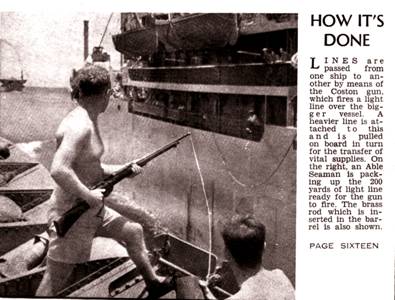
COSTON GUN
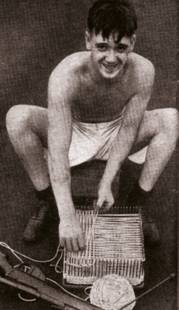
A SEAMAN PREPARING THE LINE FIRED BY THE COSTON GUN TO A SHIP SAILING ALONGSIDE. THE LINE IS THEN USED TO TRANSFER A LARGE CABLE. IT IS THEN POSSIBLE TO TRANFER PERSONNEL, SUPPLIES OR FUEL FROM ONE SHIP TO ANOTHER. INJURED SAILORS WERE TRANSFERRED USING A SPECIAL STRETCHER, NAMED AFTER W. HEATH ROBINSON (1872-1944), A CARTOONIST AND ILLUSTRATOR KNOWN FOR DRAWINGS OF ECCENTRIC MACHINES DURING WORLD WARS I AND II.
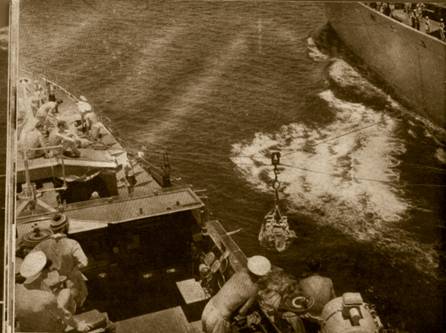
TRANSFER OF SUPPLIES.
JOHN GOODCHILD WAS TRANSFERRED IN A BOSUN'S CHAIR WHICH OCCASIONALLY DIPPED SO CLOSE TO THE SEA THAT HE WAS SOMETIME SOAKED ON ARRIVAL
John Goodchild was on the Nepal when it was trying to contact the Tjitjalengka, a former Dutch troop transport ship which had been converted into a hospital ship, and was staffed by British medical teams. The Geneva Convention stipulated that hospital ships should be a safe distance from the war areas. However re-supplying and re-fuelling were needed and thus destroyers were dispatched to provide the next meeting points for supply transfer. For security reasons these directions had to be made by hand signals. Tjitjalnengka was eventually found and a new meeting point was given.
After the Americans delivered an atomic bomb on Hiroshima (6-8-1945) and the "Fat Boy" on
Nagasaki the Japanese surrendered.
374 allied ships congregated in Tokyo Bay, and the battleship Missouri was selected to
receive the Japanese surrender.
On August the 30th the Australian and New Zealand ships arrived at Yokosuka Bay
and Captain H.G.J. Buchanan received the keys to the base from a Japanese official.
Goodchild was present on the Missouri for the formal signing of the Japanese surrender.
As usual, he was able to find a prime position, and using a 16 mm movie camera, he filmed
the ceremony. It shows the Japanese in top hats, and the various Allied commanders in their
uniforms. The Japanese Foreign Minister Namoru Shigematsu had a wooden leg and tripped over
a small step. He took a brief moment to re-adjust it. It may well be the only such record by
an Australian in the War Museum.
One of the Japanese questioned at the base mentioned that there was an unregistered prisoner
of war camp at Ofuna. Goodchild commandeered a truck, and using the card shown above and a
friendly chat with the Americal guards, arrived at the camp. It was some 15 miles
from Yokosuka and was not registered with the Red Cross. It held 130 prisoners. Four were
British, one from New Zealand, and the rest were American.
The following news articles and photographs were sent to Canberra by Goodchild.
MacArthur issued strong rules about forces leaving their bases and when Captain Buchanan discovered Goodchild visiting the camp for the second time he ordered him from his ship. Typically, Goodchild was able to persuade the Americans who had "dry" ships to take him (with some beer) to a British ship, the King George V. The whole fleet was celebrating the victory and the bay was alight with ships lights and rockets. He met Admiral Rawlings, drew his portrait, had some friendly drinks and was offered a return trip to Australia.
John Goodchild was also keen to paint some Japanese customs and local scenes.
Some of Goodchild's last paintings were of the devastation of Yokohama and Tokyo. He
set up his easel among the ruins and debris of Yokohama. Little groups of people out
foraging for food gathered around him. They invited him into their makeshift
shelters, bowed and offered him tea. Only two buildings remained standing: The
press communication centre of Reuter's, and the British Embassy. The latter was
re-opened for business as usual as if no one was aware that the last days of a
major war have just taken place.
John Charles Goochild contributed over 150 articles, paintings, photographs and sketches
documenting his experiences.
He was formally discharged on the 8th of January
1946.
-o0o-
